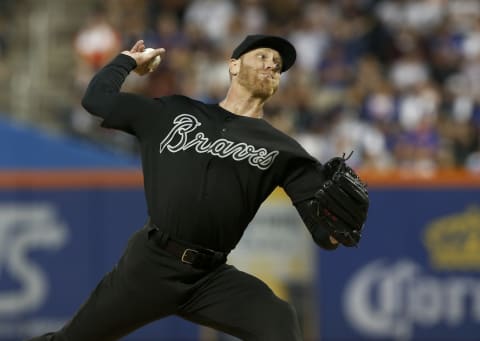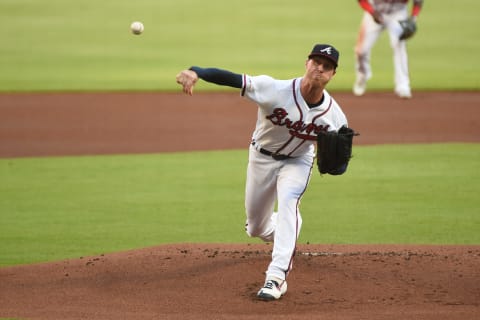Atlanta Braves: Mike Foltynewicz needs to leap forward in 2020


The Atlanta Braves got an effective Mike Foltynewicz down the stretch after a miserable start to the season. Now, they’ll need Folty to take a big step forward in 2020 after fighting to bounce back.
Mike Foltynewicz was the main acquisition – and the lone remaining acquisition – from the 2015 trade that sent (then) Atlanta Braves catcher Evan Gattis to the Houston Astros.
Two other prospects were involved in that deal: Rio Ruiz is now with the Baltimore Orioles, and pitcher Andrew Thurman was released after reaching AA Mississippi with the Atlanta Braves.
Foltynewicz has become a fan favorite and has been a solid pitcher for the Braves. He tantalized fans with a break out 2018 season that saw him make his first All-Star team, marking him as one of the best pitchers in the National League, but struggled to duplicate that same success in 2019.
The 28-year-old righty has always shown the flashes of brilliance that stood tall during the 2018 season.
For example, on June 30, 2017, Folty took a no-hitter into the ninth inning on the road against the Oakland A’s. He gave up a home run to lead off the inning, but that was just one example of what the fiery and sometimes emotional hurler could do.
Here’s a look at his numbers during his time with the Atlanta Braves:
- 2015: 15 starts, 86.1 innings, 4-6 record, 5.71 ERA, 8.0 K/9, 3.0 BB/9
- 2016: 22 starts, 123.1 innings, 9-5 record, 4.31 ERA, 8.1 K/9, 2.6 BB/9
- 2017: 28 starts, 154 innings, 10-13 record, 4.79 ERA, 8.4 K/9, 3.4 BB/9
- 2018: 31 starts, 183 innings, 13-10 record, 2.85 ERA, 9.9 K/9, 3.3 BB/9
- 2019: 21 starts, 117 innings, 8-6 record, 4.54 ERA, 8.1 K/9, 2.8 BB/9
We’ll get more into a tumultuous 2019 season on the next slide, but outside of 2018, Folty’s numbers look pretty similar. What was different in 2018?
His slider was more effective. He got more swings and misses, giving up less contact. In 2018, he only gave up 6.4 hits per nine innings. His second best mark was 8.4 in last year.
It takes good sense — when Folty’s slider is dominant, he nears elite levels as a pitcher. When it’s not, it tends to hang and spin less, and Major League hitters don’t miss hanging sliders too often. MLB hitters can all hit fastballs, but for Folty, it’s all about the slider having that dive.

The ups and downs of a season
The photo above is a great depiction of Folty celebrating, and it was well deserved. However, when April turned to May, and even later into the summer, it didn’t appear if he would be involved in any celebration at all.
It all started with an elbow issue in spring training that sidelined him, pushing back the start date to his season. When his season started, it came via a rehab assignment with the AAA Gwinnett Stripers. It didn’t go well.
After his first start of a rehab assignment that featured five innings of shutout baseball, his next three starts lasted 12.2 IP and he gave up 12 runs on 17 hits. Folty walked seven batters, hit another and struck out 12. Despite an underwhelming performance, he was recalled, but things didn’t improve.
Upon his return, he made 11 starts, pitching 53.1 innings. When his earned run average ballooned to an ugly 6.37 after giving up eight runs to the Washington Nationals, he was optioned to Gwinnett. Looking deeper, Folty struck out 50 batters and walked 20, which is good, but his slider didn’t have that bite and hung in the zone. That, in part, led to him giving up 16 home runs during that stretch.
Folty spent the month of July in the minors, but improved significantly, and further improved, until he was recalled by the Atlanta Braves on Aug. 5.
During that stint in the minors he pitched 33.2 innings, allowing 10 earned runs on 27 hits. Most importantly, he struck out 31 batters to just eight walks and didn’t allow a single home run.
Down the stretch, Folty was back to his old self again. He only gave up more than three runs once, on Aug. 11 against the Marlins, and he still picked up the victory. The Braves won nine of his ten starts. The lone loss came to the New York Mets on Aug. 28 after the division was wrapped up. The Braves couldn’t support a solid start and fell 3-0.
The postseason
Unfortunately for Foltynewicz, he put together one of the best postseason starts in Atlanta Braves history and one of the worst starts— in the same series.
In Game 2, he posted seven shut out innings, allowing three hits, striking out seven and issuing no walks. He out-dueled St. Louis Cardinals ace Jack Flaherty and evened the series at one game a piece.
The only thing about his Game 5 start that was similar was that he only allowed three hits. Those three hits were accompanied by three walks and Folty allowed six earned runs and recorded just one out before being pulled from the game. Once the floodgates were open, it didn’t stop, and the Cardinals won 13-1.

What Folty will we get?
It’s impossible to really know what version of Folty the Atlanta Braves fans will see in 2020. I will say that there’s a nice chunk of fans out there that are ready to write him off because of Game 5.
I am not among those people. I’ll give you that 2019 was a crazy year of ups and downs, but I can’t see the logic in the fans that are ready to wash their hands of him.
Folty has the skills to be an All-Star and he already showed that. That leads me to believe that he can still be an elite pitcher — an ace type. Now, I’ll counteract that by saying that the time is now. Another up-and-down season or a year where his emotions get to him, something of that nature— and I’m not a buyer. Right now, I am.
The Illinois native should slot in as the number two starter behind everyone’s favorite Canadian, Mike Soroka. (Sorry, Scott Thorman). The Atlanta Braves starting rotation could border on the elite this year. However, that’s only going to happen if Folty is at his peak.
Barring any lingering effects from his spring training injury, it appears that his roller-coaster 2019 season appears to be cerebral. That is almost as scary to fans as a major injury. However, with the Atlanta Braves in a window where they can contend for a World Series title, I think that you’ll see a focused Foltynewicz on the hill in 2020.
Next. New season, new hope. dark
My prediction for Foltynewicz’s season: 16-8, 3.15 ERA, 190Ks.